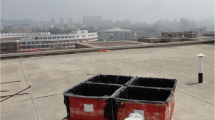Abstract
Oil pollution can be monitored by infrared remote sensing technology. In this work, the degree of polarization (DOP) was established as a quantitative index of oil pollution. The crude oil and the local typical surface soil from the Songyuan oil field in Jilin province were collected. Some soil samples with four levels of oil content and three levels of water content were prepared and measured. The DOP of the polluted soil and the clean soil in the field was also measured at 180° relative viewing azimuth angle, and 10°, 30° and 50° viewing zenith angles. It was found that with rising soil oil content, the DOP of the reflected light on the soil surface increased when the soil water content was low, and decreased when the soil water content was high.
Similar content being viewed by others
References
Li S. Application of remote sensing for oil slicks detecting and its progress. Rem Sens Inform, 2007, 74(2): 53–57
Taylor S. 0.45 to 1.1 μm spectra of prude crude oil and of beach materials in Prince William sound. Alaska, CRREL special report No. 92-5, Cold regions research and engineering laboratory, Hanover, New Hampshire, 1992, 14
Fingas M F, Brown C E, Mullin J V. The visibility limits of oil on water sensing thickness detection limits. In: Proceeding of the fifth thematic conference on remote sensing for marine and coastal environments. Arbor A, eds. Environmental research institute of Michigan, Michigan, 1998. 411–418
Pantani L, Cecchi G, Bazzani M. Remote sensing of marine environments with the high spectral resolution fluorosensor-FLIDAR 3. SPIE, 1995, 56–64
Mussetto M S, Yujiri L, Dixon D P, et al. Passive millimeter wave radiometric sensing of oil spills. In: Arbor A, eds. Proceedings of the second thematic conference on remote sensing for marine and coastal environments: needs, solutions and applications, Michigan, 1994. 35–46
Mastin G. A, Mason J J, Bradley J D, et al. A comparative evaluation of SAR and SlAR. In: Arbor A, eds. Proceedings of the second thematic conference on remote sensing for marine and coastal environments: needs, solutions and applications, Michigan, 1994, 393–397
Singh K P. Monitoring of oil spills using airborne and spaceborne sensors. Adv Space Res, 1995, 15(11): 101–110
Zhao Y, Huang F, Jin L. Study on polarizing reflectance characteristics of plant simple leaf. J Rem Sens, 2004, 4(2): 131–135
Suits G H. The calculation of the birectional reflectance of a vegetation canopy. Rem Sens Env, 1972, 2: 117–125
Suits G H. The cause of azimuthal variations in directional reflectance. Rem Sens Env, 1972, 2: 175–182
Hapke B W. Bidirctional reflectance spectroscopy 1. Theor J Geophys Res, 1981, 86: 3039–3054
Hapke B W. Theory of Reflectance and Emitance Spectroscopy. Cambridge: Cambridge Univ Press, 1993
Li X, Strahler A H. Geometric optical modeling of a coniferous forest canopy. IEEE Trans Geosco Remote Sens, 1985, 23(2): 207–221
Xie F, Wu F, Liu J, et al. Treatment of petroleum contaminated soil by two-step washin. Oilf Chem, 1997, 14(1): 86–88
Millard J P, Arvesen J C. Polarization: A key to an airborne optical system for the detection of oil on water. Science, 1973, 180: 1170–1171
Curran P J. Polarized visible light as an aid to vegetation classification. Rem Sens Env, 1982, 12: 491–499
Curran P J. The relationship between polarized visible light and vegetation amount. Rem Sens Env, 1981, 11: 87–92
Curran P J. A photographic method for the recording of polarised visible light for soil surface moisture indications. Rem Sens Env, 1978, 7: 305–322
Zhao Y, Jin L, Zhang H, et al. Studies on the polarized reflectance characteristics of soil. J North Norm Univ, 2000, 32(4): 93–97
Zhao Y, Jin L, Song K, et al. Study on the characteristics of polarized reflectance on l liquid surface. J North Norm Univ, 2000, 32(4): 103–106
Zhao H, Yan L, Zhao Y. Study on multi-angle polarized reflectance spectrum of granite. Jmineral Petrol, 2004, 24(2): 9–13
Zhao H, Yan L, Zhao Y. Multi-angle polarized reflectance spectrum of peridotite. Geol Prosp, 2004, 40(2): 51–54
Zhao Y, Wu T, Luo Y, et al. Research on quantitative relation between polarized bidirectional reflectance and bidirectional reflectance of water-surface oil spill. J Rem Sens, 2006, 10(3): 294–298
Song K, Zhao Y, Zhang B. The polarized reflectance characteristics of some soils. Chin J Soil Sci, 2004, 35(4): 420–425
Zhao Y, Wu T, Hu X. Study on quantitative relation Between Multi-angle polarized reflectance and bidirectional reflectance. J Infr Mill Waves, 2005, 24(6): 441–444
Wu T, Zhao Y. The bidirectional polarized reflectance model of soil. IEEE Trans Geosc Rem Sens, 2005, 43(12): 2854–2859
Zhao H, Yan L, Zhao Y. Multi-angle polarized reflectance spectrum of soil. Acta Ped Sin, 2004, 41(3): 476–479
Author information
Authors and Affiliations
Corresponding author
Additional information
Supported by the National Natural Science Foundation of China (Grant No. 40572167, 40771153), National Program for Key Basic Research Projects (973 Program) (Grant No. 2004CB418505) and Platform of Scientific and Technological Innovation in the Eleventh Five-Year Plan of Northeast Normal University
About this article
Cite this article
Wang, Y., Sheng, L., Li, K. et al. Measurement of light polarization characteristics from an oil-polluted soil surface in near-infrared bands. Chin. Sci. Bull. 54, 1607–1612 (2009). https://doi.org/10.1007/s11434-009-0067-9
Received:
Accepted:
Published:
Issue Date:
DOI: https://doi.org/10.1007/s11434-009-0067-9




